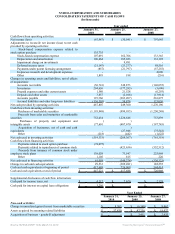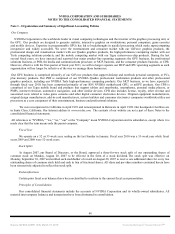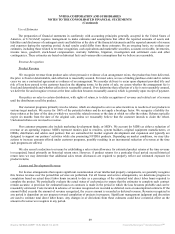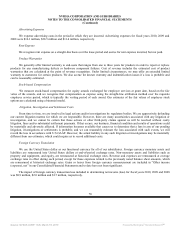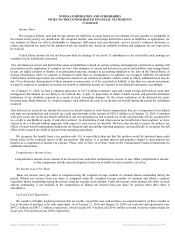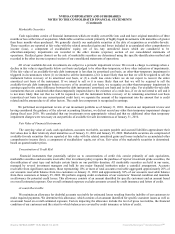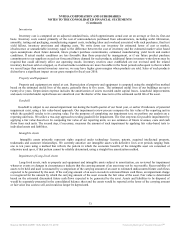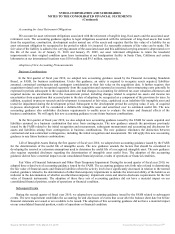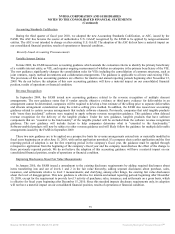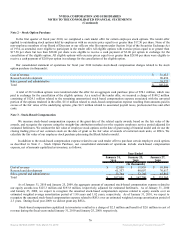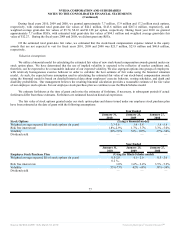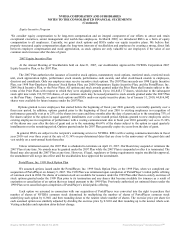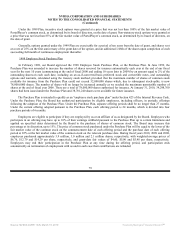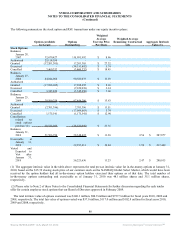NVIDIA 2010 Annual Report Download - page 93
Download and view the complete annual report
Please find page 93 of the 2010 NVIDIA annual report below. You can navigate through the pages in the report by either clicking on the pages listed below, or by using the keyword search tool below to find specific information within the annual report.
NVIDIA CORPORATION AND SUBSIDIARIES
NOTES TO THE CONSOLIDATED FINANCIAL STATEMENTS
(Continued)
Inventories
Inventory cost is computed on an adjusted standard basis, which approximates actual cost on an average or first-in, first-out
basis. Inventory costs consist primarily of the cost of semiconductors purchased from subcontractors, including wafer fabrication,
assembly, testing and packaging, manufacturing support costs, including labor and overhead associated with such purchases, final test
yield fallout, inventory provisions and shipping costs. We write down our inventory for estimated lower of cost or market,
obsolescence or unmarketable inventory equal to the difference between the cost of inventory and the estimated market value based
upon assumptions about future demand, future product purchase commitments, estimated manufacturing yield levels and market
conditions. If actual market conditions are less favorable than those projected by management, or if our future product purchase
commitments to our suppliers exceed our forecasted future demand for such products, additional future inventory write-downs may be
required that could adversely affect our operating results. Inventory reserves once established are not reversed until the related
inventory has been sold or scrapped, so if actual market conditions are more favorable in the fiscal periods subsequent to that in which
we record larger than normal inventory reserves, we may have higher gross margins when products are sold. Sales of such products
did not have a significant impact on our gross margin for fiscal year 2010.
Property and Equipment
Property and equipment are stated at cost. Depreciation of property and equipment is computed using the straight-line method
based on the estimated useful lives of the assets, generally three to five years. The estimated useful lives of our buildings are up to
twenty-five years. Depreciation expense includes the amortization of assets recorded under capital leases. Leasehold improvements
and assets recorded under capital leases are amortized over the shorter of the lease term or the estimated useful life of the asset.
Goodwill
Goodwill is subject to our annual impairment test during the fourth quarter of our fiscal year, or earlier if indicators of potential
impairment exist, using a fair value-based approach. Our impairment review process compares the fair value of the reporting unit in
which the goodwill resides to its carrying value. For the purposes of completing our impairment test, we perform our analysis on a
reporting unit basis. We utilize a two-step approach to testing goodwill for impairment. The first step tests for possible impairment by
applying a fair value-based test. In computing fair value of our reporting units, we use estimates of future revenues, costs and cash
flows from such units. The second step, if necessary, measures the amount of such impairment by applying fair value-based tests to
individual assets and liabilities.
Intangible Assets
Intangible assets primarily represent rights acquired under technology licenses, patents, acquired intellectual property,
trademarks and customer relationships. We currently amortize our intangible assets with definitive lives over periods ranging from
one to ten years using a method that reflects the pattern in which the economic benefits of the intangible asset are consumed or
otherwise used up or, if that pattern cannot be reliably determined, using a straight-line amortization method.
Impairment of Long-Lived Assets
Long-lived assets, such as property and equipment and intangible assets subject to amortization, are reviewed for impairment
whenever events or changes in circumstances indicate that the carrying amount of an asset may not be recoverable. Recoverability of
assets to be held and used is measured by a comparison of the carrying amount of an asset to estimated undiscounted future cash flows
expected to be generated by the asset. If the carrying amount of an asset exceeds its estimated future cash flows, an impairment charge
is recognized for the amount by which the carrying amount of the asset exceeds the fair value of the asset. Fair value is determined
based on the estimated discounted future cash flows expected to be generated by the asset. Assets and liabilities to be disposed of
would be separately presented in the consolidated balance sheet and the assets would be reported at the lower of the carrying amount
or fair value less costs to sell, and would no longer be depreciated.
73
Source: NVIDIA CORP, 10-K, March 18, 2010 Powered by Morningstar® Document Research℠


